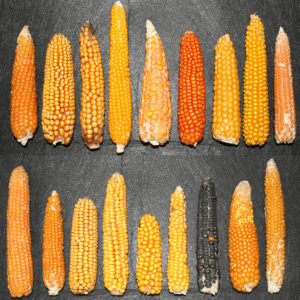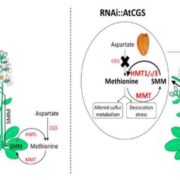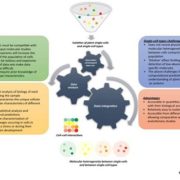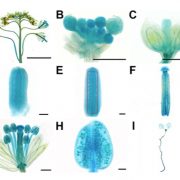Using Metabolism to Improve Maize Breeding
Cañas et al. study the relationships between maize leaf metabolism and grain yield to identify putative markers for breeding http://www.plantcell.org/content/29/5/919
By Rafael A. Cañas, Peter J. Lea and Bertrand Hirel
In crops, several metabolic pathways are involved in the control of biomass production and yield, notably those involved in primary carbon and nitrogen metabolism. For these metabolic pathways, metabolite fluxes and metabolite accumulation strongly depends on the plant genetic background and on the environmental conditions.
Maize is now ranked first among crops, comprising 41% of the total world cereal production. It is mostly used for feeding animals and humans and to a lesser extent the production of biofuel and starch-derived commercial products. Maize was domesticated more than 7,000 years ago in Mexico and then exported and cultivated in the rest of the world. The worldwide expansion of maize cultivation allowed the creation of a huge reservoir of genetic resources. These genetic resources are now used by breeders to improve maize productivity and by scientists to decipher the genetic and physiological basis of grain and biomass production.
Most scientific approaches developed so far have not been able to link plant metabolism to agronomic traits such as yield. We developed a new modelling approach to investigate whether there was any relationship between leaf metabolism and grain production, by combining metabolomics with analysis and modelling of enzymatic reactions, metabolite flux, and physiological and agronomic traits. Taking advantage of maize genetic diversity, we used this approach to study nineteen genetically distinct maize lines from Europe and America.
During grain filling, leaf metabolic composition appeared to be a reliable marker, allowing a classification matching the genetic diversity of the lines. Both correlation studies and metabolic network analyses allowed the description of a maize ideotype (model of a new variety) with a high grain yield potential. Such an ideotype is characterized by a low accumulation of soluble amino acids and carbohydrates in the leaves and a high activity of enzymes involved in the C4 photosynthetic pathway and in the synthesis of amino acids derived from glutamate. Specific metabolites known as chlorogenates appear to be important markers that can be used to select for maize lines that produce larger kernels.
Genes controlling the synthesis and accumulation of metabolites might also be used as markers for breeding high yielding maize varieties. Optimizing their positive impact on plant productivity will require modifying their level of expression through genetic engineering or marker-assisted breeding in an integrated and coordinated way.
Cañas, R.A., Yesbergenova-Cuny, Z., Simons, M., Chardon, F., Armengaud, P., Quilleré, I., Cukier, C., Gibon, Y., Limami, A.M., Nicolas, S., Brulé, L., Lea, P.J., Maranas, C.D., and Hirel, B. (2017). Exploiting the Genetic Diversity of Maize Using a Combined Metabolomic, Enzyme Activity Profiling, and Metabolic Modeling Approach to Link Leaf Physiology to Kernel Yield. Plant Cell 29: 919-943.










Leave a Reply
Want to join the discussion?Feel free to contribute!